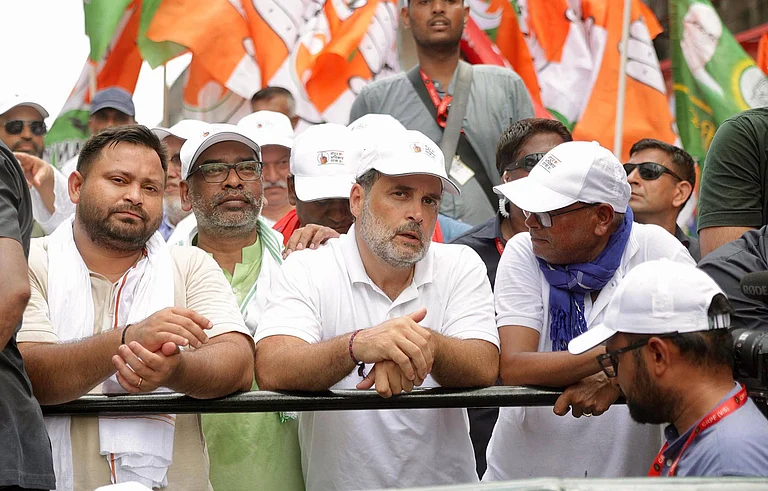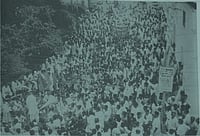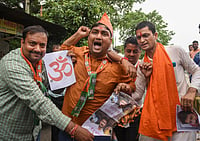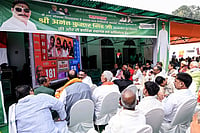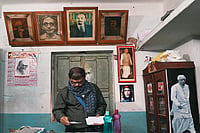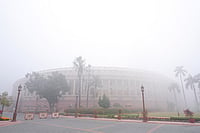
Congress dominated Bihar until the 1980s with 169 seats and 39% vote share, but Mandal politics and the JP Movement fragmented its base.
The party lacks charismatic local leaders and a Bihar-specific narrative, with Delhi-centric appointments creating weak state units overshadowed by BJP's nationalism, RJD's social justice, and Nitish's governance
To revive, Congress must decentralize leadership, rebuild grassroots organization, project credible OBC/Dalit faces, and reclaim the EBC-Dalit-Minority
On a November morning in Patna, a few Congress workers gather under the fading signboard of the Sadaqat Ashram — once the ideological nerve centre of Bihar’s freedom movement, is now an echo chamber of nostalgia. The party office, with its yellowing portraits of Mahatma Gandhi and Rajendra Prasad, feels more like a museum than a political headquarters. It’s here that you begin to understand how a party that once ruled Bihar unchallenged now survives on the fringes of alliances.
From the empty rooms of its state office to the crowded rallies of the Mahagathbandhan, the Congress party doesn’t find too many supporters. Among the many rallies of the alliance that Outlook attended, there were barely any participants who talked about the Congress party. The Grand Old Party of India doesnt exist on the ground. But that was not always the case.
The Fall of the Old Order
Until the 1980s, Congress was Bihar’s natural party of power. From Krishna Ballabh Sahay to Bindeshwari Dubey, the state was governed by Congress stalwarts who held together a coalition of upper-caste elites, backward classes, Dalits, and Muslims. But it was a party led by upper caste and feudal families. In the 1980 Bihar Assembly election, the Congress won 169 of 324 seats, securing over 39% of the vote— a dominance that made it appear unassailable.
But beneath that stability simmered resentment of the backward castes. The Congress order was paternalistic — rooted in patronage, not participation. The JP Movement of the 1970s cracked this order open. When Jayaprakash Narayan called for a “total revolution,” Bihar’s youth and backward-caste leaders — men like Lalu Prasad Yadav and Nitish Kumar — took it as a call to upend the Congress’s political monopoly.
By the late 1980s, the tectonic shifts of Mandal politics redefined power. The 1990 election — held in the wake of the Mandal Commission’s implementation and the rise of Janata Dal — reduced Congress to 71 seats with just 24% of the vote. Within a decade, the party’s traditional social base had fragmented: upper castes gravitated toward the BJP, OBCs rallied behind Lalu, and Muslims, once Congress’s most loyal constituency, chose the RJD as the new guardian of secularism in the state.
Through 1990s and the 2000s the party could neither reinvent itself nor find a face who could command respect beyond a few districts. In the 2000 Assembly election, the Congress’s decline became stark: it won only 23 seats, its vote share slipping below 12%. By 2010, that share fell further to 8.4%, and the party managed a mere 4 seats — its lowest tally in history.
The 2015 election offered a brief reprieve, when as part of the RJD-JD(U)-Congress Mahagathbandhan, it secured 27 seatsand nearly 7% of the vote, riding on anti-BJP sentiment and the charisma of the grand alliance. But by 2020, it was back to just 19 seats with a 9.5% vote share, confirming that the revival was fleeting, not structural.
“We used to vote for the Congress Party. Not only my father, grand father but my caste largely voted for the Congress supporters,” said Parshuram Pandey, a resident of Tiwaridih in Terari assembly constituency.
No Face, No Story
In Bihar the Congress has neither a leader with local charisma nor a narrative which could attract the Biharis. The BJP speaks the language of nationalism; the RJD invokes social justice; Nitish Kumar sells good governance and stability. But what does Congress offer?
“The Congress Party doesn't have a Bihar specific imagination. It needs to learn a lot from someone like Prashant Kishor’s Jan Suraaj Party which has captured the imagination of the state electorate through its Bihar specific agenda and narrative,” said Nirnimesh Kumar added Bihar-based analyst.
Rahul Gandhi’s joint rallies with Tejashwi Yadav, and his Vote Adhikar Rally briefly rekindled enthusiasm among younger voters, but the energy was not organisationally channelled. Local Congress leaders remained disconnected from grassroots realities. Even now, the Congress’s Bihar unit speaks more about national issues than the state’s agrarian distress, unemployment, or migration.
The Cost of Centralisation
Much of the Congress’s stagnation in Bihar stems from its Delhi-centric control. State presidents are appointed not through local consensus but by the high command’s balancing act between caste and loyalty. The result: leaders like Akhilesh Prasad Singh, Madan Mohan Jha, or Ashok Choudhary (before his defection to JD(U)) have functioned more as coordinators than mobilisers.
A former Congress MLA put it bluntly: “Our leaders wait for instructions from Delhi, while BJP leaders get instructions from booths.”
The Congress has depended entirely on alliances to remain electorally relevant. In the Mahagathbandhan, it has ceded both leadership and ideological space to the RJD.
Tejashwi Yadav, though still untested in governance, is now the de facto face of the opposition — not the Congress’s state chief.
“The Congress Party doesnt mean much in Bihar. It needs to have young charismatic leaders. For instance, It should let leaders like Pappu Yadav and Kanhaiya Kumar to grow and strengthen the party organizational structures. But it is subservient to Lalu who doesnt want any competition to his son Tejaswi. That is the main reason why Kanhaiya is no where to be seen in Bihar elections,” added Kumar.
This dependency has strategic costs. “Congress can’t grow under RJD’s shadow,” says Aneesh Ankur a political commentator. “But it also can’t afford to leave the alliance. It’s a classic Catch-22.”
The party’s best performance in recent years — 27 seats in 2015 — came when the Mahagathbandhan wave was at its peak. Without that tailwind, Congress finds itself adrift again.
A Crisis of Imagination
The deeper crisis, however, is ideological. Congress leaders in Bihar are unsure whether to lean into social justice politics or position themselves as a centrist alternative to both BJP’s Hindutva and RJD’s populism. In a state where political identities are forged around caste, community, and development, the local Congress leadership doesnt know which issues to claim as one’s own.
A young Congress worker in Darbhanga put it more simply: “Humare paas neta bhi nahi, nara bhi nahi.” — We have neither leaders nor slogans.
And yet, Bihar is ripe for a political alternative. Nitish Kumar’s “Sushasan Babu” image has faded; Lalu’s social justice plank feels dated; and BJP’s Hindutva appeal faces fatigue. In this vacuum, new entrants like Prashant Kishor’s Jan Suraaj Party have found resonance by promising jobs, governance and dignity.
If Congress had invested in grassroots re-organisation and projected a fresh, locally credible OBC or Dalit leader, it might have reclaimed some lost ground. But the party’s unwillingness to de-centralise has cost it the very state that once symbolised its secular, pluralist promise.
If the Congress is ever to matter again in Bihar, it must unlearn its habit of outsourcing politics to alliances and rediscover the craft of social coalition-building. That means reclaiming the EBC–Dalit–Minority triangle — sections alienated from both the RJD’s Yadav-centric social justice and the BJP’s upper-caste Hindutva. It also means cultivating charismatic local leaders who can command people's loyalty. A decentralised Congress leadership— one that speaks in Bhojpuri and Maithili accents, could still find space in Bihar’s crowded political bazaar.










